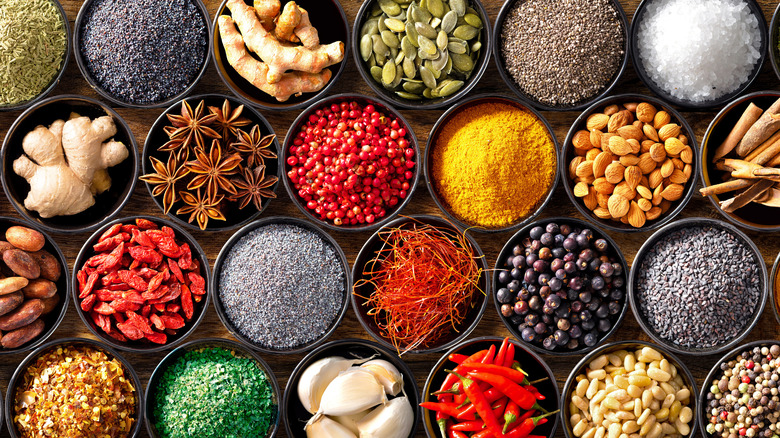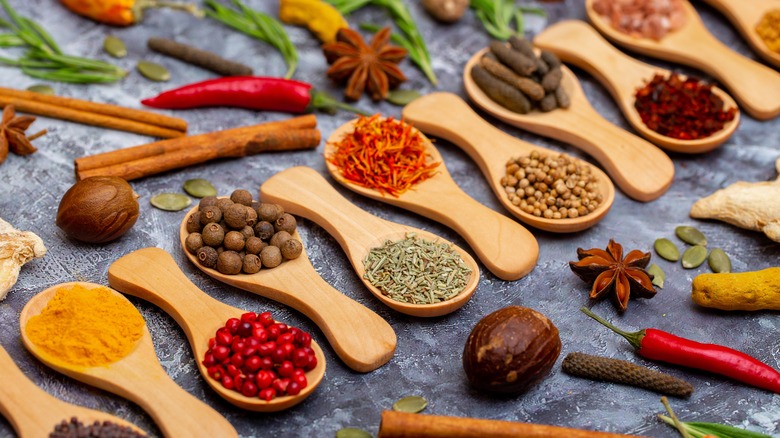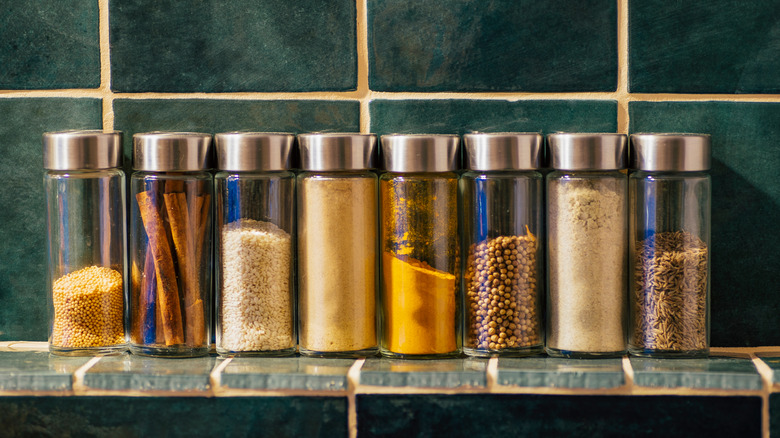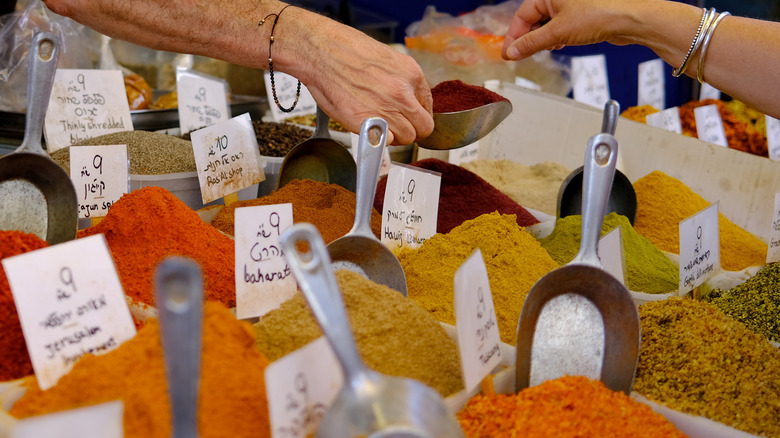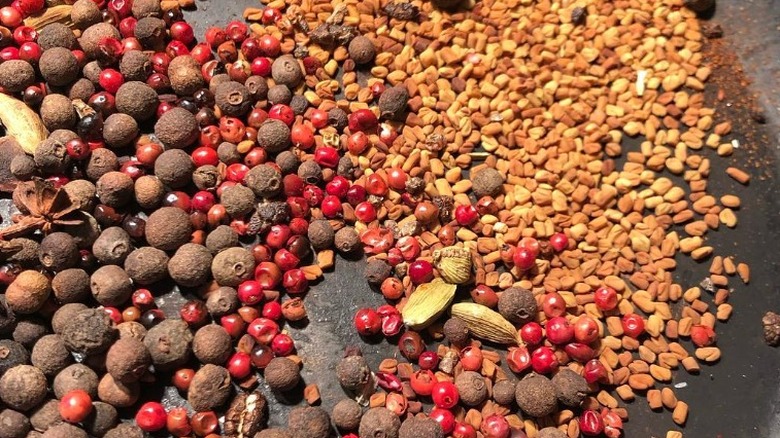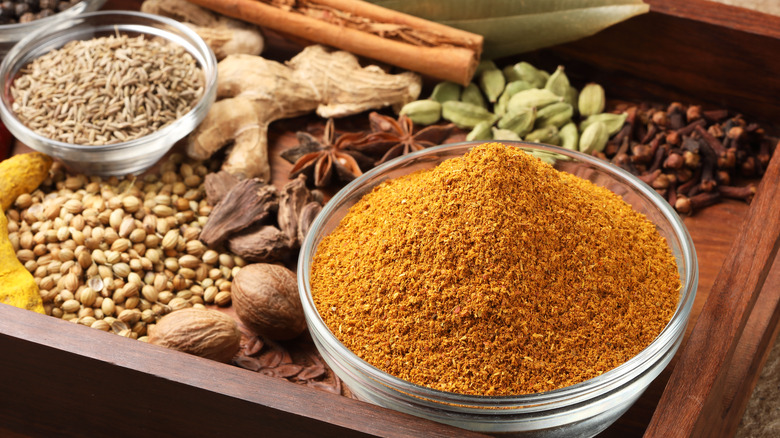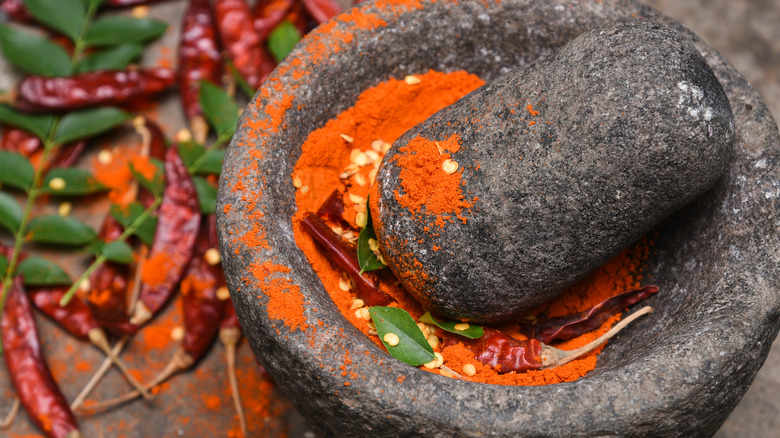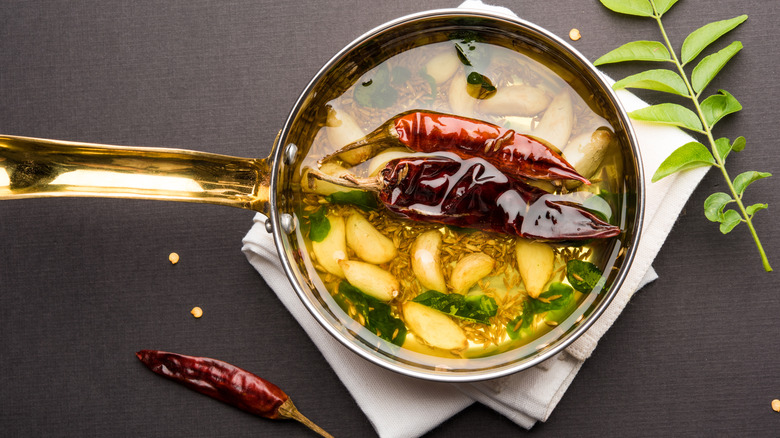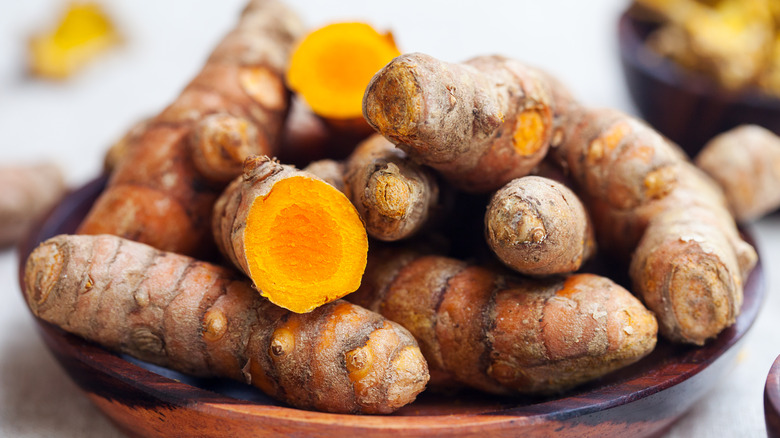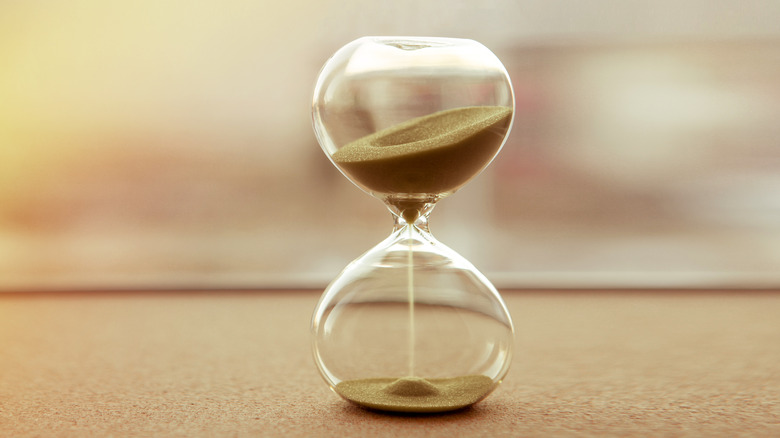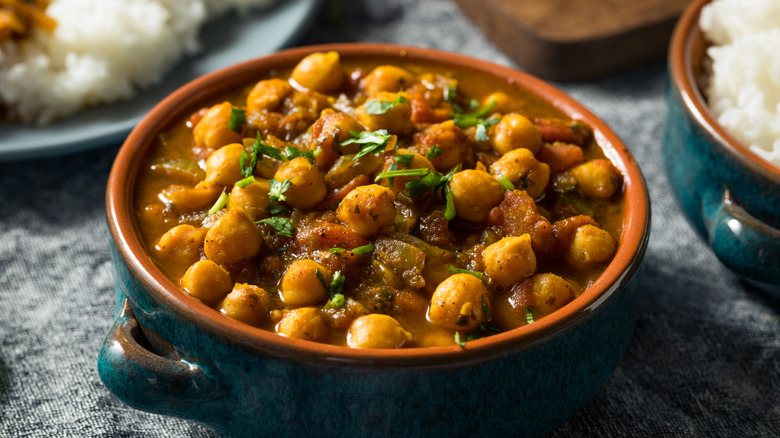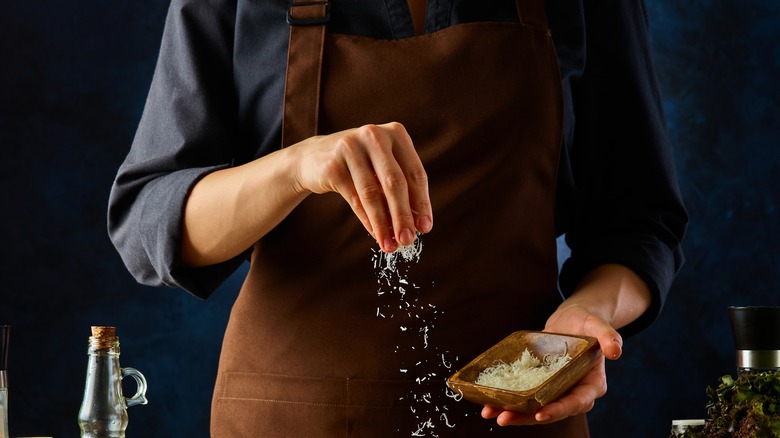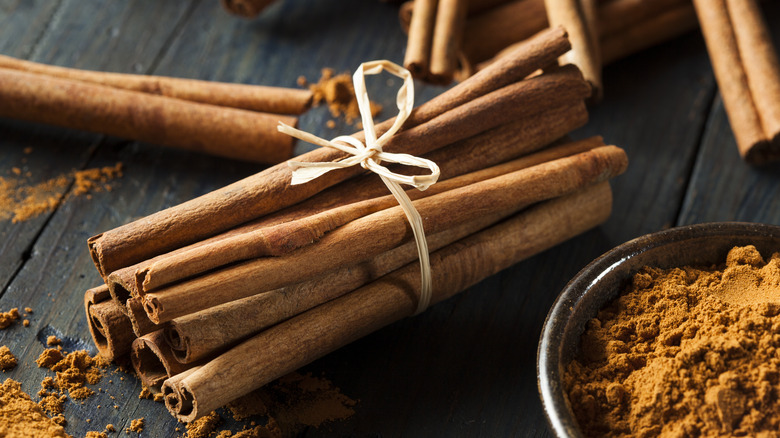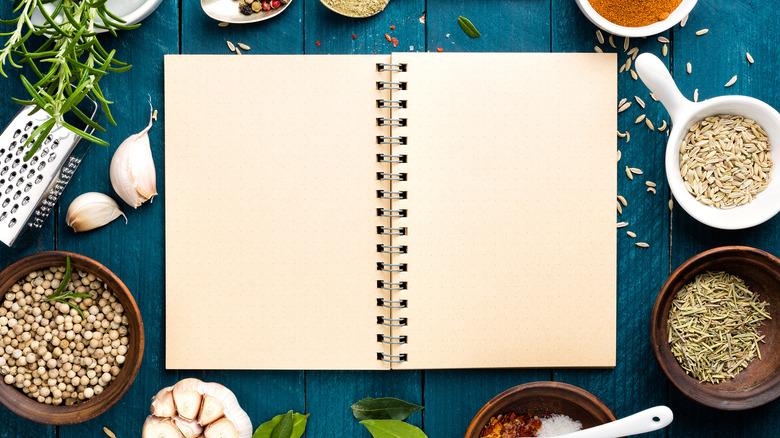12 Tips You Need When Cooking With Spices
Enter spices: A commodity that has not only been used for centuries to make food taste oh-so-much better but also changed the course of history. We often forget that the world's food looked very different not so long ago. India had no chili powder, the U.S. had no nutmeg, and Europe had no black pepper.
Beginning in the Roman era and peaking with the British Raj, the market for spices is directly responsible for establishing trade routes, promoting globalization, and developing infrastructure along coastal regions, per the BBC. It sparked a fight for dominance that would have far-reaching consequences across many continents and change our diets forever. As a direct result of this, in the 21st century, we have an array of spices at our disposal. It's possible to experiment with many cuisines previously out of reach: Mexican, Indian, Chinese, Ethiopian, Iranian, and many more.
Chances are you've used spices many times without thinking twice. From vanilla in desserts to black pepper on pasta, we use them more than we know — but cooking with an arsenal of spices can seem like a big learning curve. Spices have the power to either make or break your dish, and that can be daunting. We're here to guide you with tips and tricks that are easy to implement and guarantee success every time. Don't reach for the pre-made spice mix just yet — stick with us and unlock a new sense of confidence with these helpful pointers.
Get familiar with spices
An often overlooked yet vital step when cooking is understanding your ingredients. In this case, it means recognizing the flavor profile that a specific spice will bring to your food, where to use it, and how to best cook with it. This knowledge will accumulate over time the more confident you become, but it will be incredibly beneficial to have some basic familiarity before you start.
Spices are commonly grouped based on their flavor and the part of the plant that yields them. According to McCormick Science Institute, spices fit into the following flavor classifications: hot, mild, and aromatic. The area of the plant where we harvest spices from are: bark, flower buds, seeds, fruits, roots, bulbs, and arils. Here's a little exercise: Work your way through the spices you know and try to categorize them based on these criteria. For example, chili peppers are hot fruits (yes, really), while cloves are aromatic flower buds.
Most importantly, once you start cooking, actively familiarize yourself by smelling and tasting each spice. Seek out new, adventurous recipes that use spices so you can put your newfound skills to the test and gain vital practice.
Store your spices in a cold, dark environment
Did you know that how you store your spices directly impacts how long they last? Ohio State University suggests you should avoid storing spices above your stove, as exposure to heat will shorten the shelf life. In addition to temperature, there are three other threats to the longevity of spices: light, oxygen, and humidity (via the Polygon Group). Firstly, light because it causes elements within the spice to break down. Secondly, oxygen as it causes loss of flavor through oxidization. And finally, humidity, as it promotes mold growth and clumping.
We advise decanting spices from their original paper or plastic packaging immediately. Transfer the spices into clean, dry, and air-tight glass containers. Store these containers away from residual steam or heat; a dark kitchen cabinet or drawer is ideal, as long as it's at an adequate distance from your stovetop and fridge. Yes, it's preferable to avoid the fridge — seasoning brand Dash reminds us that refrigerators have high humidity levels that are detrimental to the shelf-life of spices.
Build your collection gradually
We're betting that you've got a spice hanging around in the back of your kitchen cabinet that you haven't used yet. Or maybe you used a quarter teaspoon in "that one recipe" and promptly forgot about it ... we've all done it. These neglected spices take up a lot of storage room, and although most have a stable shelf life under the right conditions, they can certainly go bad. For this reason, we recommend following Madhur Jaffrey's tips for stocking up on spices. The Indian cookbook author and food expert suggest buying your spices gradually, based on a shopping list for the recipe you plan on cooking. This shopping technique results in a well-curated spice collection based on your personal preferences rather than fads or trends. It also prevents you from feeling overwhelmed and gives you a clear, streamlined vision.
It's also worth analyzing which spices your favorite cuisine uses most regularly. Scottish chef and restaurateur Gordon Ramsay has a list of spices you should have in your pantry, ranging from turmeric to sumac. While the list is far from comprehensive, it spans a range of seasonings suitable for cooking dozens of dishes.
Toast your spices for maximum flavor
The aim of cooking with spices is to enhance your dish with complex flavors. However, it's not as simple as adding a few teaspoons of spice to your pan. If you want to draw out the flavors of your spice to their maximum potential, there are a few techniques that you should have under your belt. The first is toasting your spices, a process that adds a whole new dimension of flavor to your recipes.
To get started, begin by adding whole spices to a heavy-bottomed saucepan. If you plan to make a spice mix, you can toast multiple spices in the same pan as long as they're of a similar size. Small spices will cook quicker than bigger ones, so it's best to toast spices with a variance in size individually. Additionally, toasted spices are best used in a recipe instantly, so we recommend only cooking as much as you require for your recipe. As per Indian food brand Kohinoor, the key to toasting your spices is to keep the heat low, "The gentle heat wakes and activates the secret aromas." Gently shake the pan and toast for around 1-2 minutes, or until the spices smell fragrant and begin to crackle. This method also works wonders for reviving old, stale spices.
Make your own spice blends
Have you ever noticed that different brands of curry powder, pumpkin spice, or Italian seasoning taste different? That's because each company may use unique ingredients and disparate levels of each spice to make their recipe. However, if you make your own, you can control precisely how much of each spice you'd like in your blend. Don't like cinnamon? No problem, you can add less. Love nutmeg? Amp it up. We recommend analyzing the ingredients in your favorite mix (ingredients are often listed from top to bottom in order of quantity used) and subsequently making your own. Toast the whole spices as instructed above, then grind to a powder. This process works for anything, from a homemade garam masala recipe to Chinese five-spice powder.
Homemade spice blends will always have the advantage of peak freshness, which is the primary reason we recommend you make your own. While shop-bought spice blends may be convenient, they're already losing potency. Besides, it's a great chance to feel like a kitchen alchemist. Not to mention the ultimate bonus: Your house will smell gorgeous.
Grind individual spices, the effort is worth it
As we've begun to establish, spices have the most intense flavor before they've been ground. Per Spices Inc, all spices contain what are known as volatile oils — chemical compounds that give them their discerning aroma and flavor. Grinding spices releases volatile oils, which is why freshly ground spices have an incredibly potent scent. The more time passes, the less concentrated the flavor and aroma become. That's why you should grind spices in small batches, using only as much as you need for one recipe. Don't stop at grinding spices for spice blends, either. Grind individual spices to use in your meals, too.
It's important to toast your spices before grinding them. This process makes them more brittle and easier to crush. While a traditional mortar and pestle works well for soft spices like black peppercorns or coriander seeds, hard ones require a more powerful gadget. We recommend an unexpected kitchen tool you can use to grind spices — a coffee grinder. Although this tool will make quick work of grinding even the toughest of spices, unless you want cumin-flavored coffee, we advise using it solely for seasonings. One downside to electric grinders is that spices tend to cling to small crevices. To prevent your pumpkin pie from tasting like chickpea curry, clean the electric grinder between uses by grinding bread or rice (both of which absorb the aromas). Use the resulting breadcrumbs or rice flour in any number of dishes.
Learn to bloom your spices
Although blooming spices may sound like a very fancy and intricate process, it's surprisingly simple. What does it mean to bloom spices? The only thing involved is heating your spices with fat (typically oil or ghee) until they burst and pop. According to small-batch spice retailer Raw Spice Bar, "heating the spices in oil releases fat-soluble flavor compounds" and distributes the flavor of spices throughout the whole dish. The process is suitable for whole and ground spices, but keep an eye on ground spices, as they can burn very quickly.
Indian cuisine relies heavily on blooming spices. A cooking method that adds new depths of flavor to spices, it's referred to in most Indian languages as tadka, translated into English as "tempering" — no relation to the chocolate-making process (via NPR). The tadka can be added at the beginning of a dish — think heating aromatic whole spices before adding onions — or at the end (to refresh and boost the flavor of anything from lentils to rice). Since the fat has to be very hot before adding your spices, it's a good idea to use oils with a high smoke point, like sunflower or canola.
Use fresh spices, not just dried
When you picture spices, it is common to imagine either ground spices or whole spices — very rarely do we visualize fresh spices like ginger, garlic, turmeric, and vanilla beans in the same category. However, fresh spices are just as important, as they impart additional flavors and textures that you are unlikely to achieve with their dried counterparts.
While fresh spices generally add a pop of interest throughout the recipe, they are also used to distribute flavor throughout the entire dish. It's all down to how you use them. They can be cut into matchsticks to garnish dishes (think julienned ginger on curry), ground into a fine paste with a microplane, or even blended into marinades. Vibrant and spicy, fresh turmeric is ideally suited to a recipe for haldi doodh, smoothies, or grated into curries. On the other hand, fresh ginger imparts more sweetness than ground ginger, which is more pungent and piquant in flavor — perfect for baking. Similarly, vanilla beans have a more potent taste than vanilla extract since alcohol and water dilute the latter. Experiment with the differences between fresh and dried, or why not use both in your recipes?
Check the expiration dates
When buying spices, we recommend opting for a brand that either has a high turnover or small-batch production. Consumers on Ranker listed behemoth Simply Organic as their favorite, and that's a justified choice. The Simply Organic website says its spices are dated for freshness, so you can tell how long the spice will stay in peak condition. If you purchase from a lesser-known store, it may be a good idea to check the expiration dates on these products — if the turnover is low and management is poor, they may miss expired products on the shelves.
Check your kitchen cabinets, too — they may be harboring expired spices. Don't rush to throw away your expired spices, though. According to Healthline, most spices that have gone bad should still be safe to consume. There is a caveat: Expired spices lose their potency and no longer bestow the same flavor they would have when fresh. If you still want to hang onto those spices, we recommend using them in larger quantities to compensate for lost intensity. In the future, avoid buying spices in bulk that may expire before you can use them. As per Insider, ground spices are best used within three weeks but can last up to two years. Whole spices, on the other hand, typically last for four years.
Layer the spices when cooking
What is the key to cooking a meal full of depth, complexity, and richness? From browning onions to adding garnishes like herbs, there are many ways to achieve a nuanced flavor. Expert home cooks know how to leverage spices to their advantage, and it all lies in a cookery technique called layering. This strategy refers to adding ingredients at different cooking stages, which helps develop elaborate taste sensations.
Most dishes will vastly improve by following this method. First, bloom whole spices in hot oil; next, add fresh spices, either grated or in the form of a paste; once they have cooked down, add ground spices; finally, top off your dish with finishing spice powders — these are typically spices that have been pre-roasted, like roasted cumin powder or garam masala. Each spice you add has a purpose and will build on the flavors of those added earlier. Whole spices infuse the oil with aroma and gently release a mild flavor into the dish, while seeds offer a pleasant burst of flavor when eaten. Fresh spices tend to have more vibrancy compared to dried ones, while ground spices intersperse throughout the whole dish, coating each ingredient with seasoning. Use each element in tandem to create an unforgettable culinary masterpiece.
Add certain spices only at the end
Strange though it may seem, some spices have already been cooked before you even open their packages. Most spice blends are made by toasting spices, then grinding them — which means the spices have already been exposed to heat. Save these spices until the end and scatter them over the dish in the last few minutes of cooking to preserve the aroma and elevate the flavor. If you fry the spices in oil, you risk dulling their fragrance and burning them. The traditional Indian spice blend garam masala is a perfect example. Indian Kitchen and Spices says of the topic, "The aromatics used in garam masala need very little heat to release its aroma and flavors. This can be perfectly achieved by adding it at the end into the hot dish."
Certain spices can also be used as an ingredient to finish cold dishes. Red chili powder, chaat masala, and cumin powder are often sprinkled on top of or mixed into cucumber raita recipes. Savory dishes aren't the only ones that get topped with a sprinkling of spice; cinnamon is commonly mixed with sugar to coat doughnuts or dusted on top of custard tarts. We advise that you practice caution when using raw spices, as the flavor can often be overpowering. The adage "You can add, but not take away" rings true.
Cook with whole spices, too
Often we see people only cooking with ground spices. Whole spices are a woefully underused ingredient with so many uses, from savory to sweet. Cardamon, cinnamon, and nutmeg are known for adding gentle warmth to desserts while providing a gorgeous fragrance to rice dishes. On the other hand, poppy seed muffins are the most well-known usage of poppy seeds — but did you know that the white variety is a traditional ingredient in some Bengali dishes? Look beyond what you already know and explore new uses for these versatile spices.
You may want to remove some whole spices before serving your food, as accidentally biting a whole cardamon pod can be an unpleasantly jarring experience. While seeds like mustard, coriander, fenugreek, and cumin are fine to eat, spices such as cinnamon, cardamom, cloves, and star anise shouldn't be consumed in their intact form. Here's a tip: Once your whole spices have bloomed in oil, remove them from your pan and place them into a tied cheesecloth or tea infuser. As your dish is bubbling away, add the tea infuser back to the pan and enjoy the benefits of the spices without worrying about removing them before serving.
Be careful when scaling up recipes
If you've ever found yourself cooking for a whole host of people, you may have needed to do some math when scaling up recipes. We've got some bad news — the math is about to get far, far worse. While most things like dessert recipes and soups can be easily halved, doubled, or tripled without affecting the outcome of your meal, it's not as simple when you cook with spices.
Talking to Southern Living, food entrepreneur Jennifer Earnest advises home cooks to add "spices in small increments" and to "taste as you go along until you reach the desired flavor level."
Though doing extra math may be unfortunate, there are some pretty basic steps you can take. For example, slowly increase your spice quantity by adding smaller amounts gradually. Then, make sure to sample your food as you go along. Tasting regularly throughout the process ensures you accurately assess the dish's flavor.
Always remember that adding too much salt or spice to a dish you're scaling up can completely ruin the flavor, so it's best to be cautious. For more specific direction, the holistic magazine Natural Health recommends adding ½ of the initial quantity for each extra serving. If you're still fearful about scaling up a recipe, it could be easier to cook as many separate servings as you require rather than attempting to cook a big batch. It takes longer, but there's less risk.
